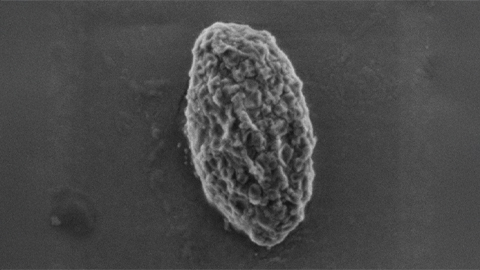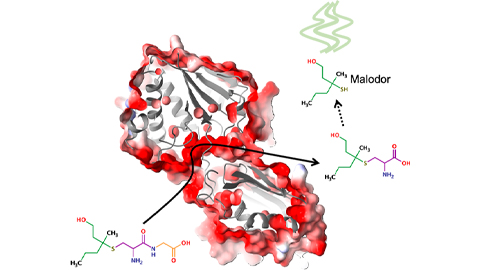
Detecting infection complications with nanoscale bacterial buds
Sepsis is an inflammatory overreaction to an infection, viral or bacterial, within the body and is the leading cause of death in hospitals. The reaction causes changes such as an intense fever or lowered blood pressure, which may damage vital organ systems if not promptly treated. Early detection may help save lives, but diagnosing patients with sepsis remains a clinical challenge.
Outer membrane vesicles, or OMVs, are nanoscale buds released from the outer membranes of Gram-negative bacteria in response to stress or other environmental changes. Bacteria use these OMVs to remove unwanted molecules and share helpful biomolecules with each other. OMVs can also trigger an inflammatory response during infection. Detecting these buds may be a quicker and more efficient way to identify Gram-negative bacterial sepsis than current diagnostic methods.

Nico Burgado, an undergraduate student in Lea Michel’s lab at the Rochester Institute of Technology, has been studying OMVs. “Usually, when doctors are trying to diagnose sepsis, the patients are already on antibiotics so when they take blood samples, no bacteria show up,” Burgado said. “We need a way to diagnose sepsis after they give the antibiotics, and a good way to do that is OMV detection.”
Burgado, Michel and their team explored OMVs in relation to E. coli sepsis. “We can detect biomolecules that are specific to the parent bacteria,” Burgado said. “After we isolate the OMVs, these biomarkers can help us determine which bacteria are causing the sepsis.”
In a recent study, the researchers used blood plasma samples collected from hospital patients by clinicians. The Michel team isolated the OMVs from these samples, using centrifugation, syringe filtering and ultracentrifugation. They then used Western blot analysis to detect the presence of E. coli proteins.
“The antigens are specific for E. coli, so if we detect any bands, that should mean that there’s E. coli OMVs in the plasma sample,” Burgado said.
The study showed that OMV detection is a promising method to diagnose Gram-negative sepsis. “The real clinical significance is that it’s a path to diagnosing sepsis, identifying the bacterial cause early on, and treating patients with the right antibiotics before they either have more complications or pass away,” Burgado said.
So far, the team has shown that, for the most part, they can isolate E. coli OMVs from the plasma of sepsis patients and detect E. coli biomarkers in the samples. In future studies, the researchers plan to test the sensitivity and accuracy of their diagnostic method and establish a baseline for detecting OMVs from E. coli and other common sources of bacterial sepsis.

Details
Nico Burgado will present this research from 4:30 to 5:30 p.m. CDT on Monday, March 25, at Discover BMB 2024, the American Society for Biochemistry and Molecular Biology annual meeting in San Antonio. His poster is at Board 273.
Abstract title: Using outer membrane vesicles to diagnosis sepsis in clinical samples
Enjoy reading ASBMB Today?
Become a member to receive the print edition four times a year and the digital edition monthly.
Learn moreGet the latest from ASBMB Today
Enter your email address, and we’ll send you a weekly email with recent articles, interviews and more.
Latest in Science
Science highlights or most popular articles

Defeating deletions and duplications
Promising therapeutics for chromosome 15 rare neurodevelopmental disorders, including Angelman syndrome, Dup15q syndrome and Prader–Willi syndrome.

Using 'nature’s mistakes' as a window into Lafora disease
After years of heartbreak, Lafora disease families are fueling glycogen storage research breakthroughs, helping develop therapies that may treat not only Lafora but other related neurological disorders.

Cracking cancer’s code through functional connections
A machine learning–derived protein cofunction network is transforming how scientists understand and uncover relationships between proteins in cancer.

Gaze into the proteomics crystal ball
The 15th International Symposium on Proteomics in the Life Sciences symposium will be held August 17–21 in Cambridge, Massachusetts.

Bacterial enzyme catalyzes body odor compound formation
Researchers identify a skin-resident Staphylococcus hominis dipeptidase involved in creating sulfur-containing secretions. Read more about this recent Journal of Biological Chemistry paper.

Neurobiology of stress and substance use
MOSAIC scholar and proud Latino, Bryan Cruz of Scripps Research Institute studies the neurochemical origins of PTSD-related alcohol use using a multidisciplinary approach.

